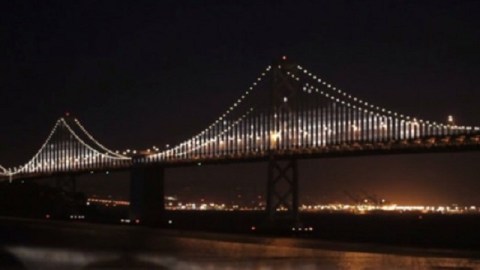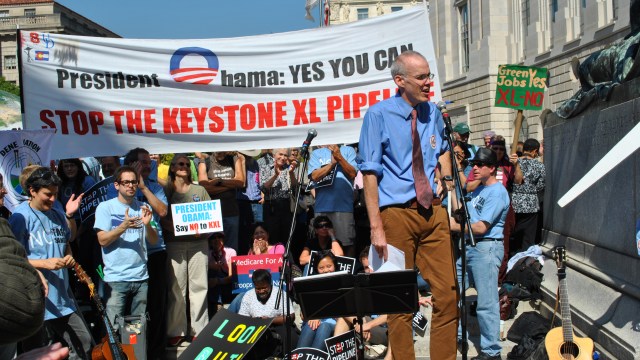Will Tech Moguls Save the Art World?

This week’s unveiling of Leo Villareal’s The Bay Lights (shown above), the world’s largest LED sculpture running along 1.8 miles of San Francisco’s Bay Bridge, shone a light on more than just the waters between San Fran and Oakland. A recent article in The Wall Street Journal profiled several “Silicon Valley power players” patronizing Villareal’s $8 million USD light show as well as making other forays into the art world. Since the Medici during the Renaissance, high finance and fine art have always found some partnership that was mutually beneficial. Just as some argue that Medici money was a mixed blessing for art, will the same be said after tech moguls have put their stamp financially on contemporary art? Silicon Valley may save the art world, but what will that art world look like afterwards?
Villareal’s The Bay Lights epitomizes what large-scale contemporary art will look like in the near future. Villareal, a researcher in Microsoft’s think tank back in the early 1990s, embodies the techie artist working today. The Bay Lights’ 25,000 white LED lights hope to twinkle in a never-repeated pattern commemorating the Bay Bridge’s 75th Anniversary from dusk to 2 am now through 2015, assuming that the $8 million USD funding goal is reached. The image above doesn’t do the dazzling display justice, but, fortunately, you can watch a livestream from the project’s homepage, where you can also keep up to date on proceedings through their social media page. If you’re really into the project and want to contribute to close the current $2 million USD funding gap, you can give “The Gift of Light” by personalizing one of those 25,000 white LED lights for yourself or a loved one. Depending on your donation level, you will also receive a laser-cut card signed by the artist, a tote bag with the Bay Lights logo (complete with an inside pocket for your iPad), or other gifts.
In Ellen Gammerman’s WSJ piece, titled “The New High-Tech Patrons,” she singles out Yahoo President and CEO (and former Google executive) Marissa Mayer and “Internet power couple” Zynga CEO Mark Pincus and his wife, Alison, as major donors to The Bay Lights. Gammerman calls Villareal “emblematic of a new breed of artist that is especially attractive to wealthy technology executives.” Gammerman characterizes this new phenomenon as a sign of the once-youthful techie crowd growing up. “Around San Francisco, tech entrepreneurs who spent years building businesses and accumulating wealth are starting to peer out from under their hoodies and explore the art world,” she explains. “As the Internet industry matures, the people who helped make it happen are having children, buying houses and taking tentative steps into philanthropy—and now the art world. It’s a lucrative emerging market that is gaining the attention of museums, dealers, consultants and other art-world heavyweights.”
The piece tries to capture how this tech invasion of art patronage differs from previous art investment waves. Gammerman quotes Trevor Traina, a 44-year-old photography collector who sold his first tech company to Microsoft for more than $100 million, as saying that “[a]n engineer will look at a photograph or video art in a way a banker couldn’t—we think in ones and zeros, we think in terms of screens.” Another difference from bankers, according to Gammerman, is that “[u]nlike on Wall Street, where a trophy canvas can work as a passport to highflying social circles, flaunting isn’t part of the tech culture.” “[I]t’s all about just being cool,” Gammerman quotes a San Francisco area dealer specializing in tech clients. Specific tech art patrons act “cool” with varying tastes: Mosaic and Netscape founder Marc Andreessen collects Robert Rauschenberg, among others; venture capitalist Matt Cohler likes contemporary photography; venture capitalist Jim Breyer (also a board member of the San Francisco Museum of Modern Art) owns work by emerging Chinese and Brazilian artists; Oracle co-founder and CEO Larry Ellison buys classic Japanese art; Yahoo co-founder and former CEO Jerry Yang purchases Chinese calligraphy; and Microsoft’s Paul Allen collects big names such as Vincent van Gogh and Mark Rothko. Gammerman also cites a pervasive tech taste for the work of Gerhard Richter, perhaps the top artist working today.
One of the heartening parts of Gammerman’s article is the variety of art that these tech figures are buying, which crosses both time periods and cultures. If all these executives and computer wizards enjoyed were computer-based art, such as Villareal’s The Bay Lights, which the artist himself calls “a whole I.T. job, which you wouldn’t associate with a monumental piece of public art,” then there might be a risk that such investments might have undue influence over what kinds of art get money to thrive and what kinds don’t. Even if technology-based art is the wave of the near future, there’s no need for it to drown all other media. It’s also nice to see that some of this patronage acts as a way of giving back. In addition to helping struggling museums, projects such as The Bay Lights help the surrounding area. “By conservative estimates, $97 million dollars will be added to the local economy,” says the project’s website, and I hope they’re right.
When looking at these modern “Microsoft Medici,” it’s important to remember that works such as Michelangelo’s David began as public works of art funded by patronage for the good of the community. David stood tall and proud as an oversized symbol of the city of Florence. The Bay Lights now stand as a symbol not only of the Bay Area itself, but also of the power of Silicon Valley to contribute more to our culture than the latest gadget and app. With economic pressures threatening to cut American society to the cultureless bone, the technology sector’s financial winners might be the last, best hope for art’s survival.
[Image:Leo Villareal. The Bay Lights, 2013.]





